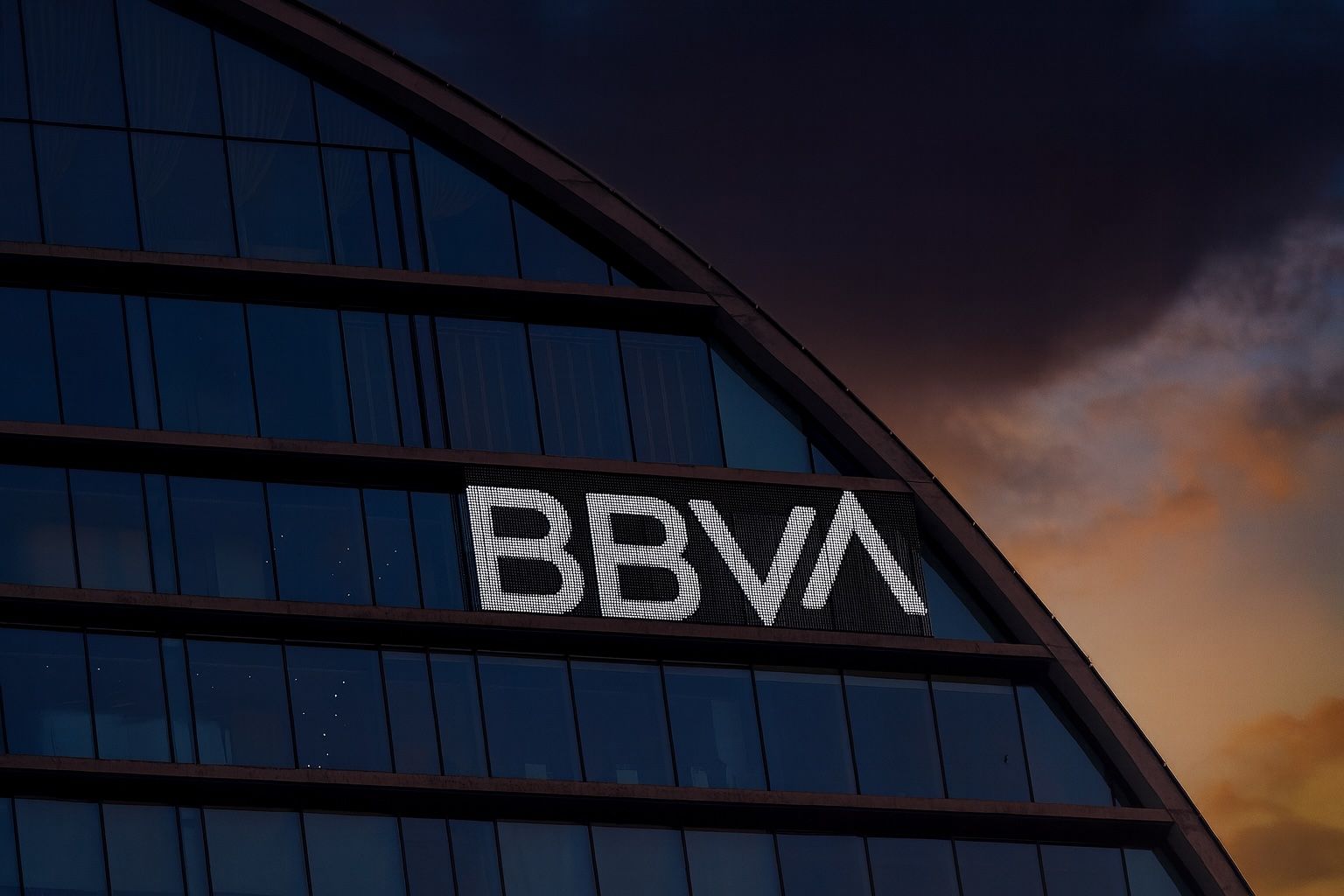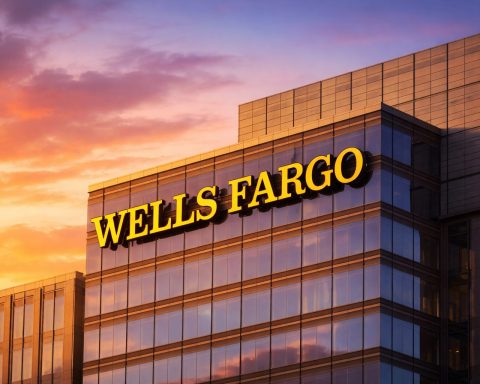- BBVA shares surged nearly 7% in Madrid on Oct. 17, 2025, hitting a fresh 52-week high after the bank’s €16.3 billion takeover bid for rival Sabadell collapsed [1].
- Investors cheered the deal’s failure as BBVA immediately resumed a €1 billion share buyback and announced a record interim dividend of €0.32 per share for November [2].
- Analysts welcomed the outcome, saying it removes uncertainty – RBC called it “a relief” after an 18-month saga [3] – and noted BBVA can refocus on core growth.
- BBVA’s stock has rallied about 75–80% over the past year [4], fueled by robust earnings (record €5.45 billion profit in H1 2025) and rising interest margins amid high ECB rates [5].
- Market sentiment remains bullish: short interest is almost zero [6] and some models predict BBVA shares could climb another ~20% in coming months if favorable trends continue [7], though upcoming earnings and economic conditions will be key.
BBVA Shares Jump as Takeover Bid Collapses
Madrid, October 17, 2025 – Banco Bilbao Vizcaya Argentaria (BBVA) stock jumped sharply on Friday after the Spanish banking giant’s hostile bid for Banco Sabadell fell through. BBVA shares rose about 5–7% in Madrid trading, closing near €16.8 (up roughly 6.9% on the day) [8] [9], while Sabadell’s stock plunged over 6% [10]. The rally came as BBVA announced it would immediately restart share buybacks – buying back €1 billion of its own shares starting October 31 – now that the Sabadell deal is off the table [11]. BBVA also declared its largest-ever interim dividend of €0.32 per share to be paid on November 7 (a 10% increase from last year) [12], effectively returning to shareholders the capital that had been earmarked for the scuttled acquisition.
The failed takeover ends a high-profile 18-month saga in Spanish banking. BBVA’s €16.32 billion (all-stock) offer for Sabadell – which would have created one of Europe’s largest lenders – flopped due to lack of investor support [13] [14]. Only about 25.5% of Sabadell shareholders tendered into BBVA’s bid, far below the minimum 50% acceptance threshold (or even a lowered 30% conditional threshold) that BBVA needed [15] [16]. Sabadell’s board had signaled the offer (sweetened in September) was too low – it amounted to just a 1.6% premium over Sabadell’s market price [17] – and major investors balked. The collapse of the deal was “a surprise to analysts and investors who expected” a higher take-up of 30–50%, according to Reuters [18].
Sabadell’s management welcomed the outcome. “The end of the takeover bid is the best path forward for Banco Sabadell and BBVA, two large institutions that generate more value separately than together,” Sabadell Chairman Josep Oliu said Friday [19]. By staying independent, Sabadell avoids a potentially difficult integration, and BBVA avoids issuing billions of new shares that would have been needed to fund the merger [20]. The result leaves BBVA firmly in charge of its own strategy going forward – and investors appear relieved by the removed uncertainty over its future direction [21].
Analysts Applaud “Relief” Outcome and Refocus
Financial experts largely applauded the failed bid as a positive for BBVA’s shareholders. Brokerage RBC Capital Markets noted the failure “comes with some relief, not because the transaction was a bad one, but because the uncertainty overhanging both banks had lasted far too long” [22]. The protracted merger talks had weighed on sentiment, and their resolution sparked a relief rally. “This outcome relieves concerns about integration risks and capital strain,” said one market strategist, commenting that BBVA dodged the challenges of digesting a major merger [23]. With the Sabadell saga over, BBVA can refocus on organic growth and its existing markets rather than a risky takeover [24].
Importantly, BBVA’s leadership is projecting confidence after the deal’s collapse. Executive Chairman Carlos Torres Vila rejected any notion of stepping down due to the failed bid and affirmed his commitment to BBVA’s strategy [25]. “At BBVA we look to the future with confidence and enthusiasm,” Torres Vila said in a message to investors, adding that the bank is “at its best” and has a clear plan for growth without the acquisition [26]. The board unanimously backed a new four-year strategic plan (unveiled in July) that targets €36 billion in shareholder distributions through 2028 – achievable now on BBVA’s own merits [27]. In fact, rather than spend on buying a rival, BBVA is channeling excess capital back to shareholders via the resumed buybacks and boosted dividends [28]. This pivot was immediate and deliberate: management wasted no time approving the €1 billion share repurchase and the one-time large dividend using funds that had been set aside for the Sabadell deal [29].
Analysts say BBVA’s decision to return capital underscores its strong financial position. “For investors, BBVA’s disciplined retreat from the deal – coupled with immediate tangible rewards in the form of buybacks and dividends – is a net positive,” observed a TS2 Tech market commentary [30] [31]. The collapse of the takeover also illustrates a broader truth: big bank mergers in Europe are tough. Hostile takeovers face cultural, political, and regulatory hurdles (BBVA’s bid drew political pushback in Spain over job and competition concerns) [32] [33], and shareholders are skeptical unless the price is very compelling. BBVA’s experience may temper other banks’ M&A ambitions in the region [34]. Instead, major banks like BBVA appear more inclined to invest in technology, pursue organic expansion and partnerships, and reward shareholders – strategies that carry fewer risks than blockbuster mergers [35].
Stock Near Highs After Year-Long Rally
Friday’s surge adds to an impressive 2025 run for BBVA’s stock. Even before this news, BBVA shares have been on an upswing for months, hovering near multi-year highs. The stock has roughly doubled in the past year, up about 75–80% on a 12-month basis [36], vastly outperforming Spain’s benchmark index and most European banking peers. Year-to-date, BBVA was already up ~77% by early October [37], and with this week’s jump it is likely even higher. In fact, the shares touched a new 52-week intraday high of €17.37 on Oct. 17 [38]. For context, BBVA traded as low as ~€8.70 within the last year [39], so it has nearly doubled from those levels. U.S. investors have also participated in the rally – BBVA’s American Depositary Receipts (NYSE: BBVA) leapt about 6–7% on Thursday after news of the deal’s failure broke late in the European day [40], indicating global enthusiasm for the development.
This week’s trading showcased volatility and volume. In the days leading up to Oct. 17, BBVA’s stock had actually pulled back slightly – it dipped 1.3% on Oct. 15 and another 0.4% on Oct. 16, as some uncertainty lingered [41]. Those modest declines were quickly erased by Friday’s relief rally. Trading volumes in BBVA exploded as well: on Oct. 16, nearly 9 million BBVA shares traded in Madrid (about double the typical daily volume) [42], and the frenzy continued into Oct. 17 as buyers piled in. Such volume spikes suggest active interest from institutional investors and momentum traders.
Notably, investor sentiment toward BBVA has been largely positive even before this news. Short interest in the stock is effectively negligible – less than 0.1% of the float is sold short [43] – implying virtually no one is betting big against BBVA. The bank also rewards shareholders with a healthy dividend (around a 4% annual yield at current prices) [44], making it attractive for income investors. At roughly 9–10 times earnings, BBVA’s stock valuation looks inexpensive relative to industry averages [45]. (Many European bank stocks trade at higher multiples, and the broader finance sector averages a much higher P/E, indicating BBVA may be undervalued for its growth and risk profile.) Indeed, some analysts see BBVA as undervalued despite its run-up – for example, a detailed Simply Wall St. analysis estimated an intrinsic value of about €24.5 per share using an excess returns model, suggesting BBVA was over 30% below fair value at the time [46]. This combination of strong momentum, solid dividends, and reasonable valuation has made BBVA a standout in the banking sector.
Strong Earnings and Economic Tailwinds
Underpinning BBVA’s stock surge are robust financial results and a supportive economic backdrop. The bank is coming off record earnings – in the first half of 2025, BBVA posted a net profit of €5.45 billion, up 9% from the prior year (and up 31% in constant-currency terms) [47]. Profitability is “among the highest in Europe,” according to CEO Onur Genç, with BBVA’s return on tangible equity exceeding 20% in H1 [48]. Revenues have been buoyed by higher interest rates: BBVA’s net interest income (what it earns on loans minus what it pays on deposits) jumped 10% year-on-year to €12.6 billion in the first half [49]. Banks across Europe have enjoyed wider interest margins thanks to the European Central Bank’s rate hikes, and BBVA is no exception [50]. Fee income also surged ~18%, reflecting strong customer activity in areas like payments and asset management [51].
Crucially, BBVA has managed to grow earnings while keeping costs efficient and credit quality in check. Its cost-to-income efficiency ratio is around 35% (extremely lean for a big bank), and it boasts a solid capital base. Major credit rating agencies have taken notice: in recent weeks all three of the big rating agencies upgraded BBVA. Fitch Ratings, for example, raised BBVA’s long-term credit rating to A- (from BBB+) on October 7 [52], citing a combination of improved macroeconomic conditions in Spain and BBVA’s own strong performance. Fitch praised BBVA’s “record of strong earnings generation, underpinned by income diversification by geography” [53]. It noted BBVA’s profits have proven “resilient… across multiple economic and interest-rate cycles” [54], thanks to the bank’s broad footprint (BBVA is Spain’s second-largest lender but also has major operations in Mexico, Turkey, and South America). Similarly, Moody’s and S&P Global upgraded BBVA earlier in the fall [55], marking some of the highest credit ratings the bank has attained in over a decade. These upgrades should lower BBVA’s funding costs and signal confidence in its stability – a bullish sign for equity investors as well.
Spain’s economic climate has been relatively favorable, which further supports banks like BBVA. Unemployment has been declining and consumer spending holding up, helping loan demand and keeping defaults low. Fitch explicitly cited the improved Spanish operating environment as a factor in its upgrade [56]. Unlike some European peers, Spanish banks also haven’t faced major domestic crises in recent years, and the government’s bank tax and other regulatory measures have been manageable. With Spain’s economy proving resilient, BBVA’s home market is providing a solid foundation for growth [57]. In addition, BBVA’s diversification means it can lean on high-growth markets like Mexico – which has been a powerhouse of earnings for the bank – to offset any softness in Europe. This geographic spread and a decentralized subsidiary model make BBVA more resilient to localized troubles [58].
Outlook – Further Upside Amid Cautious Optimism
Looking ahead, market watchers believe BBVA still has room to run, though perhaps at a more measured pace. Technical analysts point out that BBVA’s stock remains in a broad upward channel despite recent swings [59]. Even after the latest jump, the shares are near the lower band of that rising trend, historically a favorable entry zone [60]. In fact, some models project the stock could rise roughly “20% over the next quarter” if the rebound continues, potentially putting BBVA in the low-€20s in the coming months [61]. Analysts at Simply Wall St. likewise classify the stock as undervalued, noting its price-to-earnings ratio (around 9x) is below both the industry average and the level justified by BBVA’s own growth outlook [62] [63]. There is a sense that BBVA’s impressive fundamentals – strong profits, high returns, and shareholder-friendly payouts – are not fully reflected in the share price yet. “Investors could be getting worthwhile value for money if the company delivers on its current trajectory,” the Simply Wall St. review concluded, after highlighting a fair P/E around 11.4x for BBVA versus the market’s 9.3x [64] [65].
However, much will depend on execution and external factors. BBVA is scheduled to report its next earnings (Q3 2025) in the coming weeks, and investors will be keen to see if the bank can maintain its profit momentum. Any signs of slowing net interest income or rising loan losses could temper the enthusiasm. Thus far, credit quality has been stable – RBC noted that corporate default rates have been manageable [66] – but as interest rates eventually stabilize or edge down, banks won’t get as big a boost from margin expansion. Morningstar bank analyst Johann Scholtz cautions that with interest rates likely past their peak, future earnings for European banks could level off or decline slightly from 2024’s highs [67]. There are also broader risks on the horizon: geopolitical tensions, a potential global growth slowdown, or renewed turbulence in emerging markets (e.g. Turkey’s currency fluctuations) could pose challenges given BBVA’s international exposure.
On the upside, the macroeconomic context still appears favorable for banks in the near term. The European Central Bank has signaled that the era of negative rates is “firmly in the past”, and even if some rate cuts occur in 2026, analysts do not expect a return to ultra-low interest rates [68] [69]. In fact, after lifting rates to ~4% earlier, the ECB is expected to keep rates at a level that’s not much below 2% going forward [70]. This implies euro-area banks may enjoy a “sweet spot”: deposit franchises generating healthy interest income, while credit costs remain in check as economies adjust gradually [71]. “People underestimated the damage that a decade of zero and negative rates did to European banks,” noted Morningstar’s Scholtz [72] – but now banks are finally reaping the benefits of a normalized rate environment. As long as loan defaults don’t spike, banks like BBVA can continue to profit from the higher rate regime without the severe downside of credit stress. So far, that balance has been favorable: “We’re almost in a sweet spot where banks benefit from these higher rates, but you’re not seeing stress on the credit side,” said one portfolio manager, summarizing the current sentiment [73].
BBVA’s strategy also points to steady growth ahead. Having stepped back from the Sabadell deal, the bank is pursuing growth organically and via technology. For instance, BBVA recently launched a 100% digital bank in Germany – entering a new market through online services rather than costly branch acquisitions [74]. This kind of expansion leverages BBVA’s strengths in digital banking (its mobile app is highly rated) and could tap new customers with relatively low risk. BBVA is also investing in fintech partnerships and its existing international franchises (such as Mexico, where it’s a market leader) to drive growth. Meanwhile, with capital to spare, the bank could consider smaller bolt-on acquisitions or simply continue returning excess capital if organic opportunities don’t use it up.
BBVA’s peers will be watching closely. Spanish banking sector comparisons show BBVA leading the pack in stock performance and profitability. Rival Banco Santander, for example, has also benefited from the interest rate windfall and solid results, but its share price rise has been more modest in 2025. CaixaBank and others likewise have strong profits yet face domestic competition and haven’t seen as dramatic a stock jump. BBVA’s outperformance is partly due to its diversified footprint and investors’ view that it has exposure to faster-growing markets. It’s notable that Spanish bank stocks as a group have outpaced many European counterparts this year [75] – aided by Spain’s vibrant economy – but BBVA in particular has been a star performer over a multi-year horizon. In fact, over the last five years BBVA’s stock is up roughly 758% (including dividends), vastly outpacing most of the sector [76]. That track record, combined with recent events, has made BBVA one of the most closely watched bank stocks in Europe right now.
For the public and investors with limited financial background, the bottom line is that BBVA is riding a wave of positive momentum. The bank’s failed takeover attempt turned into a short-term boon for its stock, as it removed uncertainty and freed up cash to reward shareholders. BBVA is making money hand over fist thanks to higher interest rates – essentially, it’s earning more on loans while still controlling costs – and it’s sharing those profits via dividends and buybacks. Experts say the bank is fundamentally strong and even after such a big rally, its shares aren’t expensive by conventional metrics [77] [78]. That said, future gains will depend on keeping profits growing and navigating any economic bumps ahead.
As of today, market sentiment around BBVA remains upbeat. The stock’s surge on Oct. 17 shows investors are optimistic about its direction without Sabadell in the picture. If BBVA continues to deliver solid earnings and growth, analysts believe its stock could see further upside. Some are already penciling in higher price targets given the bank’s performance and capital return plans. Of course, prudent investors will watch upcoming earnings and any signals from the ECB or economy closely. But for now, BBVA stands as a case study of a European bank thriving in a new financial landscape – one where higher interest rates and disciplined strategy have turned it into a banking powerhouse that is rewarding shareholders and attracting global attention.
Sources: BBVA stock and Sabadell bid outcome – Reuters [79] [80]; RBC analyst quote – Reuters via GBAF [81]; Market and strategist commentary – TS2.tech [82]; BBVA management quotes and plans – TS2.tech [83] [84]; Recent stock performance and forecast – TS2.tech [85] [86]; Simply Wall St. analysis – Simply Wall St. [87] [88]; BBVA earnings and financials – BBVA H1 results via TS2 [89] [90]; Fitch upgrade – BBVA/Fitch via TS2 [91]; European banks context – Reuters [92] [93].
References
1. www.reuters.com, 2. ts2.tech, 3. www.globalbankingandfinance.com, 4. simplywall.st, 5. ts2.tech, 6. ts2.tech, 7. ts2.tech, 8. www.investing.com, 9. www.reuters.com, 10. www.reuters.com, 11. ts2.tech, 12. ts2.tech, 13. ts2.tech, 14. ts2.tech, 15. ts2.tech, 16. ts2.tech, 17. ts2.tech, 18. www.reuters.com, 19. www.reuters.com, 20. ts2.tech, 21. ts2.tech, 22. www.globalbankingandfinance.com, 23. ts2.tech, 24. ts2.tech, 25. www.reuters.com, 26. ts2.tech, 27. www.reuters.com, 28. ts2.tech, 29. ts2.tech, 30. ts2.tech, 31. ts2.tech, 32. ts2.tech, 33. ts2.tech, 34. ts2.tech, 35. ts2.tech, 36. simplywall.st, 37. simplywall.st, 38. www.investing.com, 39. www.investing.com, 40. ts2.tech, 41. ts2.tech, 42. ts2.tech, 43. ts2.tech, 44. ts2.tech, 45. ts2.tech, 46. simplywall.st, 47. ts2.tech, 48. ts2.tech, 49. ts2.tech, 50. ts2.tech, 51. ts2.tech, 52. ts2.tech, 53. ts2.tech, 54. ts2.tech, 55. ts2.tech, 56. ts2.tech, 57. www.reuters.com, 58. ts2.tech, 59. ts2.tech, 60. ts2.tech, 61. ts2.tech, 62. simplywall.st, 63. simplywall.st, 64. simplywall.st, 65. simplywall.st, 66. www.reuters.com, 67. www.reuters.com, 68. www.reuters.com, 69. www.reuters.com, 70. www.reuters.com, 71. www.reuters.com, 72. www.reuters.com, 73. www.reuters.com, 74. ts2.tech, 75. www.reuters.com, 76. simplywall.st, 77. simplywall.st, 78. simplywall.st, 79. www.reuters.com, 80. www.reuters.com, 81. www.globalbankingandfinance.com, 82. ts2.tech, 83. ts2.tech, 84. ts2.tech, 85. ts2.tech, 86. ts2.tech, 87. simplywall.st, 88. simplywall.st, 89. ts2.tech, 90. ts2.tech, 91. ts2.tech, 92. www.reuters.com, 93. www.reuters.com







